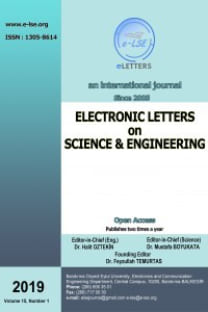Bazi Asit-Tuz Çözeltilerinin Radyo Frekans Altinda Kayip ve Dispersiyon Faktörlerinin Yapay Sinir Aglari Kullanilarak Tahmin Edilmesi
Elektrolitik çözeltilerin öziletkenlikleri( ) s , esdeger iletkenliklerine, elektrolitik dirençlerine, çözelti konsantrasyonuna ( ) g bagli olarak degisim göstermektedir. Bu degisim elektrolitler için daha ayirt edici detayli çalismalar yapmamiza olanak saglamistir. Bu çalismada elektrolitik çözeltilerin bazi özellikleri Radyo-Frekans (RF) elektromanyetik alanlar kullanilarak incelenmistir. Bu uygulama için pek çok farkli yöntem kullanilmaktadir. En çok bilinen iki yöntemden birisi köprü digeri ise rezonans yöntemidir. Bu çalismada rezonans yöntemi kullanilmistir. Rezonans yöntemi indüktif ve kapasitif ölçme hücresi olmak üzere iki farkli durum içerir. Bu çalismada indüktif ölçme hücresi tercih edilmistir. Bunun nedeni ise indüktif yöntemin kapasitif yöntemden deneysel olarak daha uygulanabilir olmasidir. Bu çalismada rezonans devresinde kalite faktöründen (Q) yararlanarak kayip faktörü -1 (c =¢¢ Q ) ve dispersiyon faktörü ( ) 2 0 2 1 w c¢ = - w HCl-MgCl2 Asit-Tuz çözeltisi için hesaplanmistir. Kayip ve dispersiyon faktörlerinin seçilen çözeltilere, devre parametrelerine ne sekilde bagli oldugu çok sayida deneyle incelenen, c¢ ve c¢¢ degerleri YSA kullanilarak hesaplanmistir.
Estimation of Loos and Dispersion Factors Study Some Acidic-Salt Solution Under Radiofrequency by using Artificial Neural Network
The special conductivity ( ) s of electrolytic solutions changes depending on their electrolytic resistance and solution concentration. These variations provide the ability of detailed investigation of electrolytic solutions. In this work, some properties of electrolytic solutions are investigated by using radio frequency (RF) electromagnetic fields. Various methods are used in this experimental study, including the bridge method and resonance method in this study, the resonance method is used. Amongst two different approaches, named inductive method and capacitive cell method. We have preferred the former one for this study. The reason for this is that the inductive method seems to be more feasible in the applications than the latter. In this study, the loss factor -1 (c =¢¢ Q ) and dispersion factor ( ) 2 0 2 1 w c¢ = - w are calculated by using the quality factor (Q), for four different solutions HCl-MgCl2, The loss factor ( ) c¢¢ and dispersion factor ( ) c¢ are investigated to depend on chosen solutions, circuit parameters in lots of experiment and founded how change is. Estimation of ( ) c¢¢ and ( ) c¢ values by using ANN
